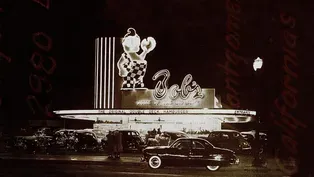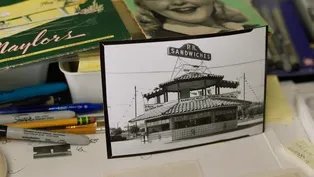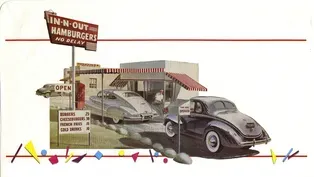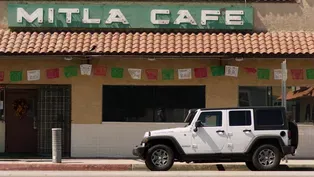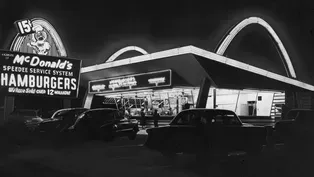
Double Burgers and Classic Cars at Bob's Big Boy
Clip: Season 6 Episode 1 | 3m 31sVideo has Closed Captions
Double hamburgers, Googie architecture and classic cars at Bob's Big Boy in Burbank, CA.
Bob's Big Boy in Burbank, California is a part of America's drive-in legacy. Join Lost LA host Nathan Masters and author and chef George Geary as they witness the bygone era of the 1940s come alive at its weekly car show and chat about the original double decker burger, possibly the inspiration for the Big Mac.
Problems with Closed Captions? Closed Captioning Feedback
Problems with Closed Captions? Closed Captioning Feedback
Lost LA is a local public television program presented by PBS SoCal

Double Burgers and Classic Cars at Bob's Big Boy
Clip: Season 6 Episode 1 | 3m 31sVideo has Closed Captions
Bob's Big Boy in Burbank, California is a part of America's drive-in legacy. Join Lost LA host Nathan Masters and author and chef George Geary as they witness the bygone era of the 1940s come alive at its weekly car show and chat about the original double decker burger, possibly the inspiration for the Big Mac.
Problems with Closed Captions? Closed Captioning Feedback
How to Watch Lost LA
Lost LA is available to stream on pbs.org and the free PBS App, available on iPhone, Apple TV, Android TV, Android smartphones, Amazon Fire TV, Amazon Fire Tablet, Roku, Samsung Smart TV, and Vizio.
Providing Support for PBS.org
Learn Moreabout PBS online sponsorshipThe drive in Golden Age faded long ago, but its legacy purrs on at one.
cherished Burbank establishment cruise down Riverside Drive and let its 70 foot neon sign.
Be your Guide.
This Bob's Big Boy opened in 1949, and while the car hops no longer glide across its blacktop, the spirit of that bygone era comes alive every Friday night at Bob's Classic car show.
I met up there with author and chef George Geary, whose book Made in California explains how places like Bob's changed the world.
So there aren't many places where you can see the Nexus between car culture and food culture.
No.
And we're losing them.
One by one.
What's left tonight is a bit of a throwback nod to their heritage.
Right?
Because it was in the late forties when.
This place opened.
How long have you been coming to these car shows?
Well, to Bob's, I've been coming 25, 30 years.
You still at the car hop, sir?
I do, But.
This one is beautiful.
Is pristine.
1957 Bel Air.
My dad had one.
And what I remember as a kid is the drink spot that you put your drink.
It's not a cup holder, but it's like an invitation.
You wouldn't dare eat a burger and fries in here.
No, no.
I've been coming here for 40 years.
Back in the day, we should park under the shade here.
So many hamburgers and awesome times.
Bob's big boy serves up more than just juicy burgers.
It's also a feast for the eyes with its iconic Googie architecture.
This style, which revs up alongside LA's car culture in the 1940s and fifties, is marked by its daring angles, vivid colors and dazzling neon, all designed to catch the eye of passing motorists.
And while many Googie structures succumb to changing tastes in the eighties and nineties, preservationists saved this classic example.
Now a cherished local landmark.
We take it for granted today that restaurants are built around the automobile.
But this car show, it reminds you how much of a novelty it was at a place like Bob's Big Boy was designed around the car and there are hardly.
Any a back east like this.
And it's California because of our weather and our car culture.
That's where everything starts is our car culture.
So what is the story of Bob's Big Boy?
There was a kid that kept coming in is how the story goes.
Yeah, And he had a slingshot in his back pocket.
They made a few burgers and then they doubled it, made the Bob's.
Big Boy out of it, And he became a very memorable icon.
Yes.
To the original.
Bob's in Glendale is gone.
yea.
It was a small little.
Stand that ground their own meat because people really didn't know what hamburgers were at 36.
You know, you did kind of a novelty.
Absolutely.
It's interesting.
Foods like that, people are surprised your grandmother didn't know what one was.
They had one they franchise of the big boy hamburger.
Not the whole concept because that was very unique.
It had two patties.
Bread in between.
You say they invented the double.
Double burger patty see original double deck hamburgers.
They're fine.
They're proud of it.
Yeah, they.
Have it, Neon if it's they are.
But yeah, they started out in the thirties.
People start copying it, but it was the original.
So is the Big Mac then, Just like a double deck knockoff?
I say yes.
Don't quote me.
Allegedly.
Okay.
There's so many fast food companies that started in California, and that's what's great about all of them, because they all have their unique history of where they are placed in our society.
Fast Food and Car Culture (Preview)
Video has Closed Captions
Iconic fast-food chains from McDonald’s to Taco Bell were born in SoCal. (30s)
Roadside Architecture Evolved With Car Culture
Video has Closed Captions
Attention-grabbing, eye-catching designs turned architecture into roadside advertising. (3m 21s)
Video has Closed Captions
In-N-Out's first burger stand on Route 66 may have given birth to today's drive-thru. (5m 22s)
Taco Bell's Fast Food Origin Story
Video has Closed Captions
Taco Bell and Del Taco can trace their fast food origins to Mitla Café in San Bernardino. (5m 52s)
How McDonald's Revolutionized Fast Food Burgers
Video has Closed Captions
McDonald's evolved from a car-hop drive-in in San Bernardino to a global fast food giant. (5m 4s)
Providing Support for PBS.org
Learn Moreabout PBS online sponsorshipLost LA is a local public television program presented by PBS SoCal
